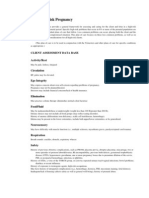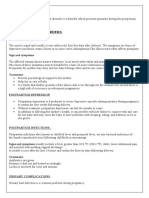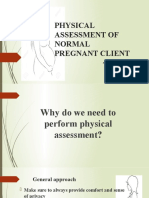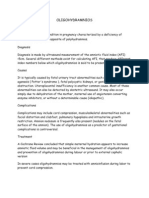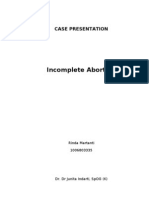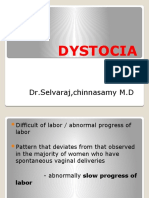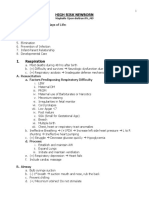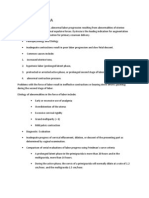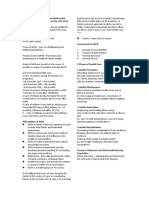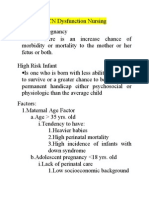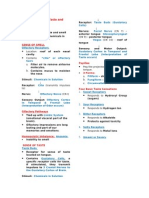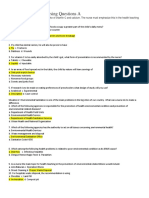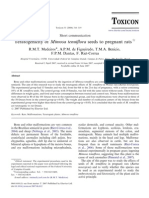Introduction To High Risk Pregnancy
Introduction To High Risk Pregnancy
Uploaded by
MabesCopyright:
Available Formats
Introduction To High Risk Pregnancy
Introduction To High Risk Pregnancy
Uploaded by
MabesOriginal Title
Copyright
Available Formats
Share this document
Did you find this document useful?
Is this content inappropriate?
Copyright:
Available Formats
Introduction To High Risk Pregnancy
Introduction To High Risk Pregnancy
Uploaded by
MabesCopyright:
Available Formats
High Risk Pregnancy: Woman with a Pre-existing or Newly Acquired Illness Risk Factors 1. 2. 3. 4. 5. 6. 7. 8. 9. 10. 11. 12. 13.
14. 15. 16. 17. 18. 19. 20. 21. 22. 23. 24. 25. 26. 27. 28. 29. 30. 31. 32. 33. 34. Age <15 reproductive organs not yet fully developed; > 35 decrease of hormones of pregnancy ; prone to illnesses, prematurity, and congenital defects Height short stature; compression of uterus to the diaphragm leads to decreased respiration. Poorly Obstetrical History Leg Pelvic Deformities such as Polio, Paralysis No Prenatal or Irregular Prenatal in previous pregnancy First Pregnancy lack of knowledge of the mother Pregnancy more than 5 Pregnancy interval <24 months from last delivery uterus may not be completely healed; can lead to uterine atony Pregnancy > 184 days or 42 weeks Pre pregnancy < 80% of standard weight Anemia < 8 grams Weight gain of <4% pre-pregnancy weight per trimester Weight gain of >4% of pre-pregnancy weight per trimester Abnormal presentation (breech and transverse) Multiple Fetuses Hypertension >140 / 90 Dizziness and Blurring of Vision (PIH) Convulsion (PIH) +Urine Albumin Vaginal Bleeding and Vaginal Infection Pitting Edema Heart or History Diseases Tuberculosis Malaria Diabetes Rubella Goiter / Thyroid Problem Heavy Smoker / Alcoholic Drinker (can lead to Fetal Alcohol Syndrome) Mental Disorder Unwed Mother Illiterate Mother Performing Heavy Manual Labor Unwanted or Unplanned Pregnancy Other Socio economic factors
High Risk Pregnancy One in which a concurrent disorder, pregnancy related complication, or external factor jeopardizes the health of the mother, fetus, or both. Factors that Categorize a Pregnancy as High Risk A. a. b. c. d. e. Psychological PRE-PREGNANCY History of the ff: Drug dependence Alcohol abuse Intimate Partner Abuse Mental Illness Poor Coping Mechanism Cognitively challenged Social Occupation involving handling of toxic substances (radiation and anaesthesia) Environmental contaminants at home Isolated Lower Economic Level Lack of support people Physical Visual or hearing disability Pelvic inadequacy or misshape Uterine incompetency, position, or structure Secondary Major Illnesses (heart disease, hypertension, chronic infections such as tb,
Survivor of childhood sexual abuse
Poor access for care Poor housing High Altitude Highly mobile lifestyle
f.
PREGNANCY Loss of support person Illness of Family Member Decrease in Self Esteem Drug Abuse, Alcohol, Smoking Poor acceptance of pregnancy
Refusal of OR neglected prenatal care Exposure to environmental teratogens Disruptive family incident Decreased economic support Conception less than a year after last pregnancy or pregnancy within 12 months of the first pregnancy
g.
Labor and Delivery Severely frightened by labor and delivery experience Inability to participate due to anesthesia Separation of infant at birth Lack of preparation for labor Birth of infant who is disappointing in some way (sex, appearance, congenital anomalies) Illness in Newborn
Lack of support person Inadequate home for infant Unplanned CS Lack of access to continued health care Lack of access to emergency personnel or equipment
hemopoietic of blood disorder, malignancy) Poor gynaecologic or obstetric history History of previous poor pregnancy outcome (miscarriage, stillbirth, intrauterine fetal death) History of child with congenital anomalies and inherited disorder Obesity PID Small stature Blood incompatibility Younger 18yo or older than 35 yo Cigarette Smoker Substance Abuser Subject to trauma Fluid and Electrolyte imbalance Intake of teratogen as a drug Multiple gestation Bleeding Disruption Poor Placental formation or position Gestational Diabetes Nutritional Deficiency of iron, folic acid, or protein Poor weight gain PIH Amniotic Fluid Abnormality Postmaturity Hemmorhage Infection Fluid and Electrolyte Imbalance Dystocia Precipitous Labor Lacerations of Cervix or Vagina Cephalopelvic Disporportion Internal Fetal Monitoring Retained Placenta
CARDIOVASCULAR DISORDERS AND PREGNANCY Cardiovascular problems that commonly causes difficulty during pregnancy: 1. 2. Valvular damage caused by Rheumatic fever or Kawasaki disease Congenital anomalies Atrial Septal Defect or Uncorrected Coarctation of Aorta Age of becoming pregnant is , so theres in Coronary Artery Disease (CAD) and Varicosities Health Care Team is needed to care during pregnancy, combining the talents of Internist, Obstetrician, and Nurse. Woman should visit OB or Family Physician before conception so team will become familiar with her health status and establish baseline evaluations of heart function such as Echocardiogram. Prenatal care should begin if pregnancy is suspected (1 week after first missed period). Blood Volume & Cardiac Output to 30% - 50% which occurs in first 28 weeks of pregnancy, and greater blood volume is maintained for the rest of the pregnancy. Because of increased blood flow, FUNCTIONAL OR TRANSIENT MURMURS can be heard and HEART PALPITATIONS on sudden exertion are normal physiologic adjustment and disappear after pregnancy. Danger of pregnancy in a woman with cardio disease occur primarily d/t in blood volume. The most dangerous time is 28 32 weeks just after blood volume peaks. .
CLASSIFICATION OF HEART DISEASE Description Uncompromised. No limitation of physical activity. Ordinary physical activity causes no discomfort No symptoms of cardiac insufficiency and angina pain. 2 Slightly Compromised Slight limitation of physical activity. Ordinary physical activity causes excessive fatigue, palpitation, and dyspnea or angina pain 3 Markedly Compromised Moderate to marked limitation of physical activity During less than ordinary activity, they experience excessive fatigue, palpitations, dyspnea, and angina pain. 4 Severely Compromised Unable to carry out any physical activity w/o experiencing discomfort. Even at rest they experience symptoms of cardiac insufficiency or angina pain. Class 1 and 2 can experience normal pregnancy and birth Class 3 Can complete pregnancy by maintaining bed rest Class 4 poor candidates for pregnancy b/c they are in cardiac failure even at rest and when they arent pregnant; usually advised to avoid pregnancy A. LEFT SIDED HEART FAILURE Occurs in conditions such as a. Mitral Stenosis and Insufficiency b. Aortic Coarctation Ventricle cant move blood forward that is received by Left Atrium from Pulmonary Circulation Class 1
Reason of failure is often at the level of Mitral Valve. Inability of the mitral valve to push blood forward causes back pressure on Pulmonary Circulation, causing it to become distended; Systemic blood pressure decreases because of cardiac output, and pulmonary hypertension occurs. When pressure in pulmonary vein reaches about 25 mmHg, fluid pass from pulmonary capillary membranes into interstitial spaces surrounding the alveoli (pulmonary edema).
Pulmonary Edema Interferes with gas exchange because fluid coats the alveoli. If pulmonary capillaries rupture under the pressure, small amounts of blood leak in the alveoli which are manifested by a Productive cough of blood speckled sputum. As O2 saturation of blood decreases from the dysfunction of the alveoli, chemoreceptors stimulate respiratory enter to increase RR. At first, this is noticeable only on exertion, then finally with rest also. A woman experiences increased fatigue, weakness, and dizziness (from the lack of 02 in brain cells). As the systemic decrease in blood pressure registers on presoreceptors in the aorta, heart rate increases and peripheral vasoconstriction occurs in an attempt to increase systemic blood pressure. As the fall in blood pressure is registered with renal angiotension system, both retention of sodium and water occurs. As Pulmonary Edema becomes severe, woman cant sleep in any position except with chest and head of bed elevated (ORTHOPNEA). Elevating the chest allows edema to settle to the bottom of the lungs and frees space for gas exchange. Woman may also notice PAROXYSMAL NOCTURNAL DYSPNEA (suddenly waking up at night short breath) because heart action is more effective when at rest. With more effective heart action, interstitial fluid returns to pulmonary circulation. This overburdens the circulation, causing increased left side failure and increased pulmonary edema If MITRAL STENOSIS - difficult for blood to leave left atrium that thrombus can occur. If COARCTATION OF AORTA is causing difficulty; both dissection of the aorta and thrombus formation can be a secondary problem; woman prescribed with antihypertensives to control BP, diuretics to reduce blood volume, and beta blockers to improve ventricular filling. A low sodium diet also may be indicated. A woman needs serial ultrasound and non-stress tests done after weeks 30 32 to monitor fetal health. Balloon Valve Angioplasty to loosen mitral valve adhesions can be performed safely during pregnancy. If an anticoagulant is required, HEPARIN is the drug of choice, for it doesnt cross placenta.
Woman with Right sided Heart Failure Congenital heart defects that causes Right Heart Side Failure: a. Pulmonary Valve Stenosis b. Atrial & Ventricular Septal Defects Output of right ventricle < blood volume received by right atrium from vena cava. Backpressure results in congestion of the systemic venous circulation and decreased cardiac output to the lungs. Blood pressure decreases in the aorta because less blood is reaching it; pressure is high in vena cava; both jugular venous distention and increased portal circulation occur. Liver and spleen become distended; liver enlargement can cause extreme dyspnea and pain because enlarged liver, as it pressed upward by enlarged uterus, puts extreme pressure on the diaphragm; distention of abdominal vessels can lead to exudates of fluid from the vessels into the peritoneal cavity (ascites).Fluid also moves from the systemic circulation into the lower extremity interstitial spaces (peripheral edema) EISENMENGER SYNDROME congenital anomaly most likely to cause right sided heart failure in women of reproductive age; a right to left or ventricular septal defect with pulmonary stenosis.
A WOMAN WITH PERIPARTUM HEART DISEASE PERIPARTAL CARDIOMYOPATHY extremely rare condition can originate late in pregnancy with no history of heart disease; although the cause is unknown, it is apparent due to the effect of pregnancy on the Circulatory System; occurs from previously undetected heart disease; occurs most often in AFRICAN AMERICAN Multiparas in conjunction with hypertension of pregnancy. Late in pregnancy, woman develops signs of MYOCARDIAL FAILURE (ex. Shortness of breath, chest pain, and edema) her heart begins to increase in size (CARDIOMEGALY). If this occurs, women need diuretic and digitalis therapy to maintain heart action. Low dose heparin may be administered to decrease risk of THROMBOEMBOLISM. IMMUNOSUPPRESSIVE THERAPY may improve symptoms. If cardiomegaly persists past post partum period, it is suggested that a woman may not attempt any future pregnancies. Oral contraceptives are contraindicated because of the danger of thromboembolism they create.
ASSESSMENT OF A WOMAN WITH CARDIAC DISEASE 1. 2. 3. 4. 5. 6. Cough Fatigue Tachycardia Tachypnea Poor Fetal Heart Tone from poor tissue perfusion Decreased Amniotic Fluid from intrauterine growth restriction Ask her about level of exercise performance (what level she can do before having shortness of breath and physical symptoms such as cyanosis of lips or nail beds) Ask if she has normally has a cough because pulmonary edema from heart failure may manifest a simple cough. Ask if she has edema. Never assess edema with heart disease lightly. Normal edema of pregnancy must be distinguished from the beginning of PIH or the edema of heart failure which are serious. Normal edema of pregnancy involves only the feet and ankles but edema of PIH or heart failure begins that way. Record a baseline V/S either in sitting or lying position at the 1 st prenatal visit and always take these in the same position for a most accurate comparison. Make comparison assessments for nail bed filling (should be <5 seconds) and jugular venous distention. Assess liver size (if theres right heart side failure; assess in early pregnancy not later for enlarged uterus presses liver upward and may be difficult to asses) ECG (may be inaccurate in late pregnancy b/c enlarged uterus presses upward on diaphragm and displaces heart laterally) Chest Xray (safe as long as abdomen is covered by a lead apron during exposure)
FETAL ASSESSMENT Cardiac Failure will affect fetal growth in which maternal blood becomes insufficient to provide adequate blood supply and nutrients to the placenta. Infants of women with severe heart disease tend to have low birth weight
Poor perfusion level may also lead to Acidotic Fetal Environment if blood flow becomes inadequate for carbon dioxide exchange.
NURSING INTERVENTIONS DURING LABOR AND BIRTH 1. 2. 3. 4. 5. 6. 7. Anesthetic of choice during Labor is EPIDURAL b/c this can make both labor and delivery less taxing. Woman should not push with contractions; pushing requires more effort than they should expend. If an epidural anesthesia is used, low forceps or vacuum extractor can be used for birth. Monitor Fetal Heart Rate and Uterine Contractions Assess BP, PR, and RR frequently. Increasing PR >100 bpm is an indication that a heart is pumping ineffectively and has increased its rate in an effort to compensate. Advise to assume a SIDE LYING position to avoid Supine Hypotension. If woman has PULMONARY EDEMA, SEMI FOWLERS POSITION to ease the work for breathing. Fatigue is a symptom of heart decompensation.
POST PARTUM NURSING INTERVENTIONS 1. 2. 3. 4. 5. Program of decreased activity and possibly anticoagulant and digoxin therapy until circulation stabilizes Antiembolic stockings and ambulation may be needed to increase venous return from legs. Oxytocin must be used with caution b/c they increase BP Should not begin post partum exercises to improve abdominal tone until Physician approves them Stool softener can be prescribed to prevent straining with bowel movements.
A WOMAN WITH ARTIFICIAL VALVE PROSTHESES One potential problem involves use of oral anticoagulants to prevent formation of clots at valve site because these medications may increase risk of congenital anomalies (pregnancy risk Category D) they are usually placed on Heparin Therapy before becoming pregnant to reduce this risk. Heparin doesnt cross placenta and doesnt interfere fetal coagulation (category C) Observe signs of Premature Separation of Placenta
A WOMAN WITH CHRONIC HYPERTENSIVE VASCULAR DISEASE Elevated Blood Pressure (140/90 mmHg) Hypertension of this kind is usually associated with Arteriosclerosis or Renal Disease Same management with PIH
A WOMAN WITH VENOUS THROMBOEMBOLIC DISEASE Combination of stasis of blood in lower extremities from uterine pressure and hypercoagulability (effect of increased estrogen) S/S a. Pulmonary Embolus b. Increased estrogen level causes increase blood coagulation c. Increased blood congestion in pelvis leads to stasis d. Poor venous return from pressure of uterus leads to stasis e. Thromboplebitis may occur
Deep Vein Thrombosis (DVT) leading to Pulmonary Emboli increases for woman 30 yrs of age or older because increased age is yet another risk factor for thrombus formation; theres pain and redness in the calf of leg. Common measures: a. Avoid use of constrictive knee high stockings b. Not sitting with legs crossed c. Avoid stranding in one position for a long period. Management: a. Bed Rest b. IV Heparin for 24 48 hours. After this she may be prescribed with SC Heparin every 12 24 hours for the duration of pregnancy. However, this site is usually avoided and injection sites are limited to arms and thighs. Woman taking Heparin during pregnancy should not take additional injections once labor begins to help reduce possibility of hemmorhage at birth c. Not candidates for episiotomy or epidural anesthesia for the same reason unless 4 hours has passed since last heparin dose was given. d. Either heparin or sodium warfarin can be prescribed after birth. Chief danger of thromboplebitis is Pulmonary Embolism or Clot lodging in Pulmonary Artery and blocking circulation to the lungs and heart. S/S of Pulmonary embolism are the ff: a. Chest Pain b. Sudden onset of Dyspnea c. Cough with Hemoptysis d. Tachycardia or Missed Beats e. Severe dizziness or fainting from lowered BP HEMATOLOGIC DISORDERS AND PREGNANCY
Involves either Blood Formation or Coagulation Disorders Because blood volume expands during pregnancy slightly increase of RBC may occur (PSEUDOANEMIA) which is normal and not be confused with true anemia.
IRON DEFICIENCY ANEMIA Most common anemia of pregnancy Deficiency of iron resulting from a diet low in iron, heavy menses, or unwise weigh reduction programs Iron stores are apt to be low in women who were pregnant less than 2 years before current pregnancy or those from low socio economic status Hemoglobin Level is <12 mg/dL (hematocrit under 33%) iron deficiency is suspected. It is confirmed by corresponding Low Serum Iron Level and Increased Iron Binding Capacity. Characteristically a microcytic (small RBC), hypochromic (less Hgb than average red cell) anemia b/c when inadequate iron is ingested, iron is unavailable for incorporation in RBC Bith Hgb and Hct will be reduced Associated with Low Birth weight and Preterm Birth Development of PICA or craving or eating of ice or starch. Fatigue and poor exercise tolerance b/c oxygen cannot be transported efficiently. Interventions a. Prenatal Vitamins containing Iron Supplement of 60mcg elemental iron as prophylactic therapy b. Diet high in iron and vitamins (green leafy vegetables, meat, legumes, fruit)
c. d.
Therapeutic levels of medication (120 180mcg elemental iron in the form of ferrous sulphate or ferrous gluconate) Iron is absorbed best with acid medium. Advise to take iron with orange juice or vitamin C
A WOMAN WITH FOLIC ACID DEFICIENCY ANEMIA Folic acid or Folacin (B Vitamin) is necessary for normal formation of RBCS in mother and prevents Neural Tube Defects in the fetus. Occurs most often in: a. Multiple Pregnancies because of increased fetal demand b. Women with second haemolytic illness in which there is rapid destruction and production of RBCS c. Women who take HYDANTONIN, an anticonvulsant agent that interferes folate absorption d. Women taking oral contraceptives The anemia that develops is MEGALOBLASTIC ANEMIA (enlarged RBCS; mean corpuscular volume is elevated in contrast with iron deficieny) Apparent during 2nd trimester of pregnancy Contributor to early miscarriage and preterm birth Pregnant women are advised to take 400ug folic acid daily, eating folacin rich foods (green lefy veggies, orange, dried beans) During pregnancy requirement increases to 600 ug/day
A WOMAN WITH SICKLE CELL ANEMIA Inherited haemolytic anemia caused by abnormal amino acid in beta chain of haemoglobin If abnormal amino acid replaces amino acid valine, sickle Hemoglobin (HbS) results; if substituted for amino acid lysine, non sickling haemoglobin (HbC) results. An individual who has heterozygous (only 1 gene in which abnormal substitution occurred) has the sickle cell trait (HbAS). If the person is homozygous (has 2 genes in which substitution has occurred), sickle cell disease (HbSS) results. RBCS are irregular or sickle shaped so cannot carry Hgb as normally shaped RBCS RENAL AND URINARY DISORDERS DURING PREGNANCY A woman with UTI 4 10% has asymptomatic Bacteriuria (organisms present in urine w/o symptoms) Because ureters dilate from the effect of progesterone, stasis of urine occurs. The minimal glucosuria that occurs allows more than usual no. of organisms to grow which causes asymptomatic UTI. Asymptomatic are dangerous b/c they can progress to PYELONEPHRITIS (infection of pelvis of the kidney) and are associated with preterm labor and PROM Organism responsible: ESCHERICHIA COLI
Assessment 1. 2. Frequency and pain on urination With pyelonephiritis Pain in lumbar region (usually on Right side) and area feels tender to palpation Nausea and vomiting Malaise frequency and pain during urination Slightly elevated temperature or may be as high as 39 40 C
3.
Infection usually occurs on the right side b/c theres greater compression and urinary stasis on right ureter from uterus being pushed by the large intestine on left side. Urine culture would reveal 100,000 organisms/ml of urine as a level of diagnostic of infection
Management 1. 2. 3. 4. Clean catch urine sample for culture and sensitivity to determine which antibiotics is needed for infection Antibiotics: Amoxicillin, Ampicillin, and Cephalosphorins. Tetracyclins are contraindicated can cause retardation of bone growth and straining of fetal teeth. Increase Fluid Intake to flush out infection (up to 3 4 Lper 24 hours) Knee Chest Position for 15 mins morning and evening so the weight of uterus is shifted forward, releasing the pressure on ureters and allowing urine to drain frequently.
A WOMAN WITH CHRONIC RENAL DISEASE May develop severe anemia during pregnancy because diseased kidneys doesnt produce erythropoetin, which is necessary for RBC formation. Assessment a. Serum Creatine Level slightly below normal (Normal: 0.7mg /100mL; during pregnancy it falls to 0.5 mg/100mL) Woman who have level of 2.0mg/dl may not be advised to be pregnant due to increased strain on already damaged kidneys that can lead to kidney failure) b. Elevated Blood Pressure from poor kidney function c. Flank Pain, if PYOLENEPHRITIS is present d. Proteinuria in urine e. Frequency and burning on urination and bacteuria if UTI is present f. Edema from inability of kidneys to evacuate fluid. Management: a. Corticosteroid (Predisone) at a maintenance level which is continued throughout pregnancy. However, infant may be hyperglycaemic at birth because of insulin suppression. b. Women may require Dialysis to aid kidney function during pregnancy. There is associated preterm labor because progesterone is removed with dialysis. To prevent this, progesterone may be administered IM before dialysis. If Hemodialysis is used, it should be scheduled frequently and for short durations to avoid acute fluid shifts. Heparin administered in connection with hemodialysis is safe during pregnancy because it doesnt cross placenta. Peritoneal Dialysis is preferred over hemodialysis b/c it cause less drastic fluid shifts. This could be accomplished on ambulatory basis.
RESPIRATORY DISORDERS AND PREGNANCY Respiratory Distress ranges from mild (common cold) to severe (pneumonia) to chronic (tuberculosis). Any respiratory condition can worsen in pregnancy because the rising uterus compresses the diaphragm, reducing the size of thoracic cavity and lung space. It can cause serious hazards to fetus to the point that the mothers gas exchange is altered or fetus cant receive enough oxygen. Nursing Dx: Risk for ineffective breathing pattern related to respiratory changes during pregnancy
a.) Acute Nasopharyngitis (Common Cold) Tends to be severe during pregnancy because estrogen stimulation normally causes nasal congestion this means that w/o minor cold, woman can find it difficult to breathe.
Aspirin should be avoided as cold remedy during pregnancy b/c of possible interference with blood clotting in both mother and fetus and possible prolonged pregnancy.
b.) Influenza Caused by virus identified as Type A, B, or C. S/S a. High fever b. Extreme prostration c. Aching pains in back and extremities d. Sore throat Management a. Antipyretic such as Acetaminophen (Tylenol) to control fever b. Influenza vaccines c.) Pneumonia Bacterial or viral invasion of lung tissue by pathogens such as: a. S. pneumonia b. Haemophilus Influenzae c. Mycoplasma Pneumoniae After invasion, an acute inflammatory response occurs with exudates of RBCS, fibrin, and polymorphonuclear leukocytes into alveoli. This confines bacteria or virus within lobes of the lungs but also fills alveoli with fluid, blocking breathing space. Theres tendency with pneumonia late in pregnancy to have preterm labor. Management: a. Appropriate Antibiotic b. Oxygen Administration (if present during labor so fetus has adequate oxygen) c. Ventilation support necessary d.) Severe Acute Respiratory Syndrome (SARS) Newly emerged infectious disease with S/S of a. Persistent fever b. Chills c. Muscle aches d. Malaise e. Dry cough f. Headache g. Dyspnea Associated with high incidence of spontaneous miscarriage, preterm delivery and intrauterine growth restriction but no evidence of perinatal SARS infection among infants. Lab finding: decreased lymphocyte and platelet count Pathogen responsible: Coronavirus which is originated from Southern China and has spread and becomes worldwide pandemic Mode of Transmission: close person to person contact via droplet transmission Incubation period: 2 10 days Management Therapy: a. IV Antibiotics
b.
Respiratory Support to survive
e.) Asthma Reversible airflow obstruction, airway hypereactivity, and airway inflammation. Associated with increased risk of perinatal complications Symptoms often triggered by irritants such as inhaled allergen such as pollen, dust, or smoke. With inhalation there is immediate release of bioactive mediators such as pollen histamine and leukotrienes from IgE/Immunoglobin interaction which results in the ff a. Constriction of Bronchial Smooth Muscles b. Marked mucosal inflammation and swelling c. Production of thick bronchial secretions These 3 processes caused reduction of the size of lumen of air passages. A woman has difficulty of pulling in air; on exhalation, difficulty in releasing air that she makes high pitched whistling sound (bronchial wheezing). Has the potential of reducing oxygen to fetus if major attack should occur during pregnancy. Have a higher rate of preterm birth and intrauterine growth restriction Management: a. Inhaled Corticosteroids Beclomethasone (Beclovent, Vancenase) and Budesonide (Pulmicort, Rhinocort). Woman who have been taking corticosteroid during pregnancy may need parenteral administration of HYDROCORTISONE during labor b/c of added stress during that time. b. Cromolyn Sodium (Intal), a mast cell stabilizer to help prevent symptoms c. Leukotriene Receptor Antagonist such as Montelukast Sodium (Singulair) or Zafirlukast (Accolate) these are oral medications (pregnancy category B) and may be continued during pregnancy f.) Tuberculosis Lung tissue invaded by MYCOBACTERIUM TUBERCULOSIS, an acid fast bacillus (+) on Mantoux Test or Purified Protein Derivative (PPD) skin test Chest Xray who shows positive reactions (shield abdomen) S/S: a. Chronic cough b. Weigh loss c. Hemoptysis d. Night sweats e. Low grade fever f. Chronic fatigue Management: a. Isoniazid (INH) b. Ethambutol Hydrochloride (Myambutol) c. Maintain adequate Calcium level during pregnancy to ensure that tuberculosis pockets form and not broken d. Wait for 1 2 years after infection becomes inactive to attempt pregnancy because recent inactive tuberculosis is more apt to become more active during pregnancy than well calcified lesions. Recent inactive tuberculosis may also be active during Postpartum period as lung suddenly returns to vertical prepregnant position allowing calcium deposits to break open. e. Although it can spread by placenta to fetus, it usually spreads to infant after birth. A woman who had history should have 3 (-) sputum cultures before she can hold and care for her baby. Theres no need to isolate and she can breastfed.
g.) Cystic Fibrosis Recessively inherited disease in which theres generalized dysfunction of exocrine glands which leads to mucous secretions, particulary in pancreas and lungs, becoming so thick that normal lung and pancreatic function is compromised. Typically develop symptoms of Chronic Respiratory Infection and overinflation of lungs from thickened mucus, inability to digest fat and protein for pancreas cant release amylase. May be identified by CHORIONIC VILLI SAMPLING or AMNIOCENTESIS Management: a. Pancrealipase (Pancrease) to support pancreatic enzymes b. Bronchodilator ELECTIVE TERMINATION OF PREGNANCY (INDUCED ABORTION) Procedure performed to deliberately end a pregnancy before fetal viability Referred as Therapeutic, Medical, or Induced Abortions. FDA approved use of MIFEPRISTONE (MIFEGYNE), an antiprogestin in connection with Misoprostol, a cervical dilating agent, for medical abortions. Reasons: a. To end pregnancy that threatens womans life (ex. Woman with class IV heart disease) b. To end pregnancy that involves fetus who have chromosomal defect c. To end a pregnancy that is unwanted due to rape or incest d. To end pregnancy who chooses opt not to have a child for such reasons as for being young, not wanting to be single parent, wanting no more children, or having financial difficulties. Before abortion, laboratory studies must be performed a. Pregnancy Test b. CBC c. Blood Typing (Including Rh Factor) d. Gonococcal Smear e. Serologic Test for Syphilis f. Urinalysis g. Pap Smear In 1973, the US Supreme Court ruled that induced abortion must be legal in all states as long as pregnancy is <12 weeks. Can regulate abortion of 2 nd trimester and can prohibit in 3rd trimester that is not life threatening. They can mandate regulations for 24 hour waiting period for counselling or requiring parental approval for minors. Signs and Symptoms of Complications After Elective Termination of Pregnancy 1. 2. 3. 4. 5. Heavy Vaginal Bleeding (>2 pads saturated in 1 hr) hemorrhage Passing of clots hemmorhage Abdominal pain or tenderness (endometritis) infection Fever over 100.4F infection (endometritis) Severe depression inadequate coping ability
Surgically Induced Abortion Procedures (Surgical Elective Termination) Involves a no. of techniques depending on gestational age at the time of abortion is performed
a.
Menstrual Extraction or Suction Evacuation simplest type of surgical abortion; performed in ambulatory basis 5 7 weeks after menstrual period; woman voids and perineum washed with antiseptic then a speculum is introduced vaginally, cervix stabilized by tenacculum, and narrow a polyethylene catheter in vagina into the cervix and uterus.The lining of uterus that would be shed by normal menstrual flow is suctioned and removed by means of vacuum pressure of syringe. Woman should remain supine for 15 mins after procedure until no uterine cramping to prevent hypertension on standing. Given oxytocin to ensure contraction.
b.) Dilatation and Curretage If pregnancy is <13 weeks it may be used. Done in ambulatory setting using paracervical anesthetic block. It doesnt eliminate pain but limits cramping and feeling of pressure on cervix Uterus is scraped clean with curette removing the zygote and trophoblast cells with the uterine lining. After procedure, woman remains in hospital for 1 4 hours with assessment of v/s and perineal care and may be given oxytocin for uterine contractions and minimize bleeding. She can return home after 4 hours if theres no complication. Has potential risk of Uterine Perforation from instruments used and risk from uterine infection compared with menstrual extraction b/c of greater cervical dilatation. Woman may be given prophylactic antibiotics to prevent infection
c.) Dilatation and Vacuum Extraction (D&E) Most 2nd trimester abortions (between 12 16 weeks) either inpatient or ambulatory. Dilatation of cervix begun before the procedure by administration of ORAL MISOPROSTOL or INSERTION OF LAMINARIA TENT (Seaweed sterile that has been dried and sterilized) into cervix.
d.) Prostaglandin or Saline Induction Used if pregnancy is between week 16 24 as inpatient or ambulatory Use of Protaglandin F2-alpha by injection or Prostglandin E-2 by suppository which causes dilatation and uterine cramping
e.) Hysterotomy If pregnancy is 16 18 weeks Removal of fetus by surgical intervention same as CS
f.) Partial Birth Abortion Used during last 3 months of pregnancy if fetus is discovered to have congenital anomaly that would be incompatible with life or result in severely compromised child NO LONGER LEGAL IN US.
You might also like
- Placenta PreviaDocument33 pagesPlacenta PreviaKinjal Vasava100% (1)
- Nutrition and Diet Therapy Summary of BookDocument17 pagesNutrition and Diet Therapy Summary of BookMabes88% (8)
- Placenta Previa and Abruptio Placenta: Presenter Eessaa ShresthaDocument72 pagesPlacenta Previa and Abruptio Placenta: Presenter Eessaa ShresthaEsa SthaNo ratings yet
- The High Risk PregnancyDocument23 pagesThe High Risk Pregnancymardsz100% (3)
- Normal NewbornDocument19 pagesNormal Newbornkozume kenmaNo ratings yet
- Prof Ad BON and NursesDocument7 pagesProf Ad BON and NursesMabesNo ratings yet
- Pathophysiology of Cataract 2Document8 pagesPathophysiology of Cataract 2Samuel Wibowo100% (1)
- @anesthesia Books 2017 EssentialsDocument346 pages@anesthesia Books 2017 EssentialsAnonymous EQnqbCT100% (1)
- Stages of LaborDocument14 pagesStages of LaborKimberly CostalesNo ratings yet
- Puerperium & Puerperal SepsisDocument15 pagesPuerperium & Puerperal SepsisMohammad HafizNo ratings yet
- Puerperium:: Psychological DisordersDocument5 pagesPuerperium:: Psychological DisordersManisha ThakurNo ratings yet
- Vacuum Extraction (Ventouse)Document3 pagesVacuum Extraction (Ventouse)dusty kawiNo ratings yet
- Placental Abnormalities Normal Placenta: © Mary Andrea G. Agorilla, Ust-Con 2021 - 1Document3 pagesPlacental Abnormalities Normal Placenta: © Mary Andrea G. Agorilla, Ust-Con 2021 - 1Mary AgorillaNo ratings yet
- Assessment of High Risk PregnancyDocument8 pagesAssessment of High Risk PregnancyJessica Carmela Casuga100% (1)
- 18 - Oligohydramnios and PolyhydramniosDocument3 pages18 - Oligohydramnios and PolyhydramniosSu OoNo ratings yet
- The High Risk PregnancyDocument23 pagesThe High Risk Pregnancynursereview100% (3)
- Benefits of BreastfeedingDocument20 pagesBenefits of BreastfeedingIan FordeNo ratings yet
- DystociaDocument17 pagesDystociaKarinaNo ratings yet
- Mechanism of LabourDocument16 pagesMechanism of LabourRadha SriNo ratings yet
- Introduction To ObstetricsDocument27 pagesIntroduction To ObstetricsDaniel NegeriNo ratings yet
- Inversion of Uterus 170225210149Document54 pagesInversion of Uterus 170225210149anju kumawatNo ratings yet
- Pregnancy Induced HypertensionDocument3 pagesPregnancy Induced HypertensionunagraciaNo ratings yet
- Malpresentation and Malposition - BreechDocument21 pagesMalpresentation and Malposition - BreechNishaThakuri100% (1)
- Physical and Physiologic Changes in Mother During PregnancyDocument29 pagesPhysical and Physiologic Changes in Mother During PregnancyANNENo ratings yet
- Preparation For ParenthoodDocument8 pagesPreparation For ParenthoodKoushik ChakrabortyNo ratings yet
- Complications in PregnancyDocument81 pagesComplications in PregnancyTia TahniaNo ratings yet
- Assessment of Fetal Growth and DevelopmentDocument30 pagesAssessment of Fetal Growth and DevelopmentWild Rose100% (2)
- Physical Assessment of Normal Pregnant ClientDocument24 pagesPhysical Assessment of Normal Pregnant ClientGhilah MaeNo ratings yet
- CPD, Dystocia, Fetal Distress OutputDocument8 pagesCPD, Dystocia, Fetal Distress OutputJohn Dave AbranNo ratings yet
- Pregnancy Induced HypertensionDocument52 pagesPregnancy Induced HypertensionJoy GloryNo ratings yet
- Danger Signs of PregnancyDocument7 pagesDanger Signs of PregnancyYyn Nita100% (1)
- 1066 Complications of 3rd Stage of Labour Injuries To Birth CanalDocument110 pages1066 Complications of 3rd Stage of Labour Injuries To Birth CanalSweety YadavNo ratings yet
- OLIGOHYDRAMNIOSDocument3 pagesOLIGOHYDRAMNIOSRuzzel Cabrera-BermonteNo ratings yet
- Drugs Used in Pregnancy, Labour and Puerperium-PBBSc NSG PreviousDocument87 pagesDrugs Used in Pregnancy, Labour and Puerperium-PBBSc NSG PreviousDivya ToppoNo ratings yet
- Health Promotion During Pregnancy MATERNALDocument9 pagesHealth Promotion During Pregnancy MATERNALRuby Jane LaquihonNo ratings yet
- Pelvic Inflammatory DiseaseDocument15 pagesPelvic Inflammatory DiseaseJay PaulNo ratings yet
- Incomplete AbortionDocument18 pagesIncomplete AbortionAra DirganNo ratings yet
- High Risk Prenatal CareDocument4 pagesHigh Risk Prenatal CareKatherine Gayle GuiaNo ratings yet
- Prelabor Rupture of Membranes (Prom) : By-Aditi Grover Roll No. - 3Document12 pagesPrelabor Rupture of Membranes (Prom) : By-Aditi Grover Roll No. - 3San SiddzNo ratings yet
- Third Stage Complications and Post-Partum CollapseDocument44 pagesThird Stage Complications and Post-Partum CollapseRamlah Ibrahim100% (1)
- Ectopic PregnancyDocument11 pagesEctopic PregnancyPrincess BalloNo ratings yet
- Dystocia: DR - Selvaraj, Chinnasamy M.DDocument54 pagesDystocia: DR - Selvaraj, Chinnasamy M.DSelvaraj ChinnasamyNo ratings yet
- High Risk NewbornDocument19 pagesHigh Risk Newbornsantosh s u100% (1)
- Puerperal InfectionDocument28 pagesPuerperal Infectionputri1114No ratings yet
- PolyhydramniosDocument2 pagesPolyhydramniosNathaniel RemandabanNo ratings yet
- High Risk NewbornDocument20 pagesHigh Risk Newborndmrdy50% (2)
- Maternal and Child Health Nursing: May Ann B. Allera, RNDocument16 pagesMaternal and Child Health Nursing: May Ann B. Allera, RNmayal100% (1)
- Purperal InfectionsDocument69 pagesPurperal InfectionsBeulah DasariNo ratings yet
- DystociaDocument31 pagesDystociamarsan120% (1)
- Framework For Maternal and Child Health NursingDocument10 pagesFramework For Maternal and Child Health NursingSHERYL TEMPLANo ratings yet
- Ceasarian SectionDocument4 pagesCeasarian SectionKeanu ArcillaNo ratings yet
- Retained Placenta After Vaginal Birth and Length of The Third Stage of Labor - UpToDateDocument19 pagesRetained Placenta After Vaginal Birth and Length of The Third Stage of Labor - UpToDateHartanto Lie100% (1)
- Problems With The PowersDocument5 pagesProblems With The PowersAlexander Ruiz Queddeng100% (1)
- MCN PartographDocument2 pagesMCN PartographAlec AnonNo ratings yet
- Conducting Vaginal Delivery Ym PDFDocument2 pagesConducting Vaginal Delivery Ym PDFyasodha maharajNo ratings yet
- Intrapartum NCM 107Document8 pagesIntrapartum NCM 107Kimberly Sharah Mae Fortuno100% (1)
- Abruption PacentaDocument6 pagesAbruption PacentaKondapavuluru JyothiNo ratings yet
- 19 Myths and Misconceptions About FP - 0Document3 pages19 Myths and Misconceptions About FP - 0iammerbinpransisko100% (1)
- High Risk Pregnancy 1Document205 pagesHigh Risk Pregnancy 1Vanessa Angel Bugarin100% (4)
- Hyperemesis GravidarumDocument16 pagesHyperemesis GravidarumGracy Casaña100% (2)
- Uterine AtonyDocument4 pagesUterine AtonyKathleen Grace ManiagoNo ratings yet
- Lower Segment Caesarean SectionDocument9 pagesLower Segment Caesarean SectionaliasLiew100% (1)
- Ventricular Septal Defect, A Simple Guide To The Condition, Treatment And Related ConditionsFrom EverandVentricular Septal Defect, A Simple Guide To The Condition, Treatment And Related ConditionsNo ratings yet
- Asepsis and InfectionDocument6 pagesAsepsis and InfectionMabes100% (1)
- Bowel Diversion: Parameter Colostomy IleostomyDocument1 pageBowel Diversion: Parameter Colostomy IleostomyMabesNo ratings yet
- PositioningDocument3 pagesPositioningMabesNo ratings yet
- CHN GapuzDocument23 pagesCHN GapuzMabes100% (1)
- Parenteral Therapy:: Intravenous Therapy (IVT) or VenipunctureDocument3 pagesParenteral Therapy:: Intravenous Therapy (IVT) or VenipunctureMabes100% (1)
- Triage PrinciplesDocument2 pagesTriage PrinciplesMabesNo ratings yet
- Commonly Asked Emergency DrugsDocument17 pagesCommonly Asked Emergency DrugsrianneNo ratings yet
- Therapeutic Diet NutritionistDocument3 pagesTherapeutic Diet NutritionistMabesNo ratings yet
- Decubitus Ulcer / Pressure SoresDocument1 pageDecubitus Ulcer / Pressure SoresMabesNo ratings yet
- Blood Transfusion Purpose: 9. Check Blood For Presence of BubblesDocument2 pagesBlood Transfusion Purpose: 9. Check Blood For Presence of BubblesMabes100% (1)
- PainDocument3 pagesPainMabesNo ratings yet
- Enema Administration: Size of Rectal TubeDocument3 pagesEnema Administration: Size of Rectal TubeMabesNo ratings yet
- DocumentationDocument3 pagesDocumentationMabesNo ratings yet
- Mabes Fluid and Electrolyte ImbalancesDocument15 pagesMabes Fluid and Electrolyte ImbalancesMabesNo ratings yet
- All Nursing TheoriesDocument26 pagesAll Nursing TheoriesMabesNo ratings yet
- Taste and SmellDocument1 pageTaste and SmellMabesNo ratings yet
- Basic or InstrumentsDocument21 pagesBasic or InstrumentsMabes100% (1)
- Suture and NeedlesDocument5 pagesSuture and NeedlesMabesNo ratings yet
- Factors That Affect Eating and NurtritureDocument3 pagesFactors That Affect Eating and NurtritureMabesNo ratings yet
- Nervous SystemDocument11 pagesNervous SystemMabes100% (1)
- Roses Are Red, Violets Are Blue, Without Your Lungs Your Blood Would Be, Too.Document249 pagesRoses Are Red, Violets Are Blue, Without Your Lungs Your Blood Would Be, Too.MabesNo ratings yet
- Nutritional Recommendation For Cardiovascular DiseaseDocument5 pagesNutritional Recommendation For Cardiovascular DiseaseMabesNo ratings yet
- Fat Soluble VitaminsDocument5 pagesFat Soluble VitaminsMabesNo ratings yet
- Water Soluble VitaminsDocument6 pagesWater Soluble VitaminsMabesNo ratings yet
- Basic Therapeutic DietsDocument3 pagesBasic Therapeutic DietsMabes100% (1)
- The Concepts of Man and His Basic NeedsDocument5 pagesThe Concepts of Man and His Basic NeedsMabes94% (18)
- Curs Pediatrie ENG 2013Document362 pagesCurs Pediatrie ENG 2013cubixmuresNo ratings yet
- Paediatrics State Exam QuestionsDocument4 pagesPaediatrics State Exam Questionsnasibdin100% (1)
- PRC - ICF - Compilations 2009-2016Document18 pagesPRC - ICF - Compilations 2009-2016Jonas Marvin Anaque100% (1)
- Gorlins SyndromeDocument6 pagesGorlins SyndromeAnupama NagrajNo ratings yet
- Risk Indicators and Interceptive Treatment Alternatives For Palatally Displaced Canines2010 - 16 - 3 - 186 - 192Document7 pagesRisk Indicators and Interceptive Treatment Alternatives For Palatally Displaced Canines2010 - 16 - 3 - 186 - 192griffone1No ratings yet
- Fetal Warfarin Syndrome PDFDocument2 pagesFetal Warfarin Syndrome PDFRickyNo ratings yet
- Mental Retardation or Intellectual DisabilityDocument15 pagesMental Retardation or Intellectual DisabilityMelody ZambranoNo ratings yet
- SEMINAR On - Doc High RiskDocument21 pagesSEMINAR On - Doc High RiskDivya Grace100% (3)
- Counseling in The Era of Personalized MedicineDocument20 pagesCounseling in The Era of Personalized MedicineDannah Liza Tatad TayoNo ratings yet
- Dengue Infection During Pregnancy andDocument7 pagesDengue Infection During Pregnancy andAlia SalviraNo ratings yet
- Community Health Nursing Questions ADocument11 pagesCommunity Health Nursing Questions AFleur Jenne100% (2)
- ICD10 Coding InstructionsDocument55 pagesICD10 Coding Instructionsanton_susanto10No ratings yet
- Case Presentation: - Vuppu BhavaniDocument53 pagesCase Presentation: - Vuppu BhavaniLohith Kumar MenchuNo ratings yet
- Boron in Drinking WaterDocument28 pagesBoron in Drinking WatercysautsNo ratings yet
- Effects of Radiation On The Developing Embryo and Fetus - Heritable Effects of Radiation Eric J. Hall, D.Phil., D.Sc.Document25 pagesEffects of Radiation On The Developing Embryo and Fetus - Heritable Effects of Radiation Eric J. Hall, D.Phil., D.Sc.Troy LivingstonNo ratings yet
- Toxicology Introduction Final PDFDocument56 pagesToxicology Introduction Final PDFنقيطة منقوطةNo ratings yet
- Tetralogy of FallotDocument31 pagesTetralogy of FallotAnditha Namira RS100% (1)
- Craniofacial MalformationsDocument162 pagesCraniofacial MalformationsDiana Lora ParvuNo ratings yet
- Cerebral Palsy: Submitted By: Prerna Sharma M.SC Nursing, 4 SemesterDocument97 pagesCerebral Palsy: Submitted By: Prerna Sharma M.SC Nursing, 4 Semestervarshasharma05100% (2)
- How I Use The Evidence in Dysphagia Management (1) : Prepared, Proactive and PreventativeDocument4 pagesHow I Use The Evidence in Dysphagia Management (1) : Prepared, Proactive and PreventativeSpeech & Language Therapy in PracticeNo ratings yet
- Approach To MacrocephalyDocument15 pagesApproach To MacrocephalywarunkumarNo ratings yet
- Drugs Pregnancy CategoryDocument14 pagesDrugs Pregnancy CategoryDevi RachmawatiNo ratings yet
- Oman ExamsDocument68 pagesOman ExamssafasayedNo ratings yet
- Gastroschisis With PhotoDocument2 pagesGastroschisis With PhotoGovardhana GiriNo ratings yet
- Ventricular Septal DefectDocument6 pagesVentricular Septal DefectYannah Mae EspineliNo ratings yet
- Artigo ToxiconDocument4 pagesArtigo ToxicontaliciabenicioNo ratings yet
- Fluconazole MSDSDocument12 pagesFluconazole MSDSShyam YadavNo ratings yet
- Sirenomelia (Mermaid Syndrome) in An Infant of A Diabetic MotherDocument2 pagesSirenomelia (Mermaid Syndrome) in An Infant of A Diabetic MotherIOSRjournalNo ratings yet



